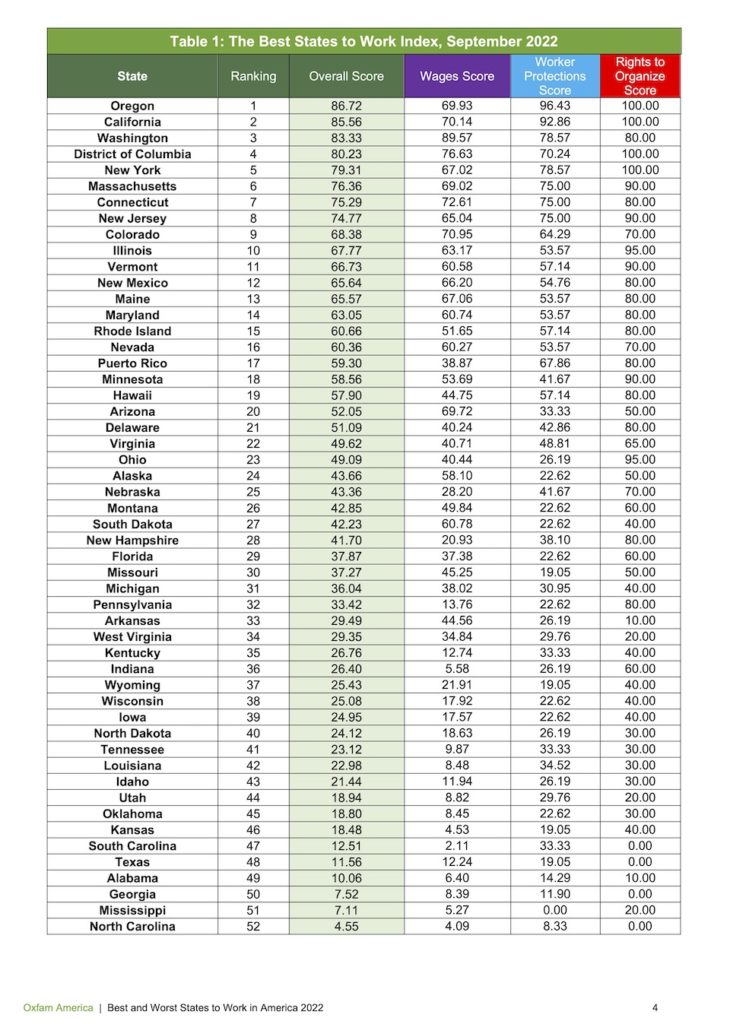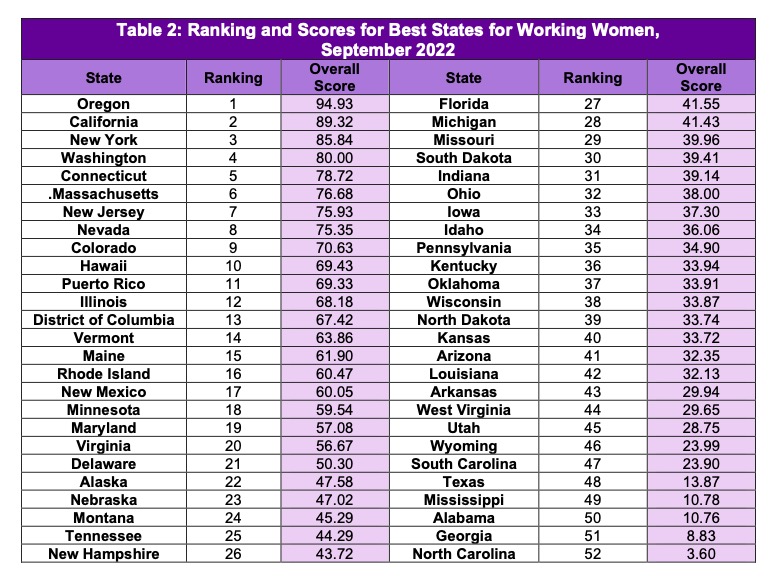As it tries to recruit immigrant labor for the next big slaughterhouse, South Dakota will have trouble standing out as a great place for workers. Oxfam’s new evaluation of worker compensation and conditions in the 50 states, D.C., and Puerto Rico ranks South Dakota just 27th-best for workers and just 30th-best for women in the workforce.


South Dakota scores 42.23 out of 100 on Oxfam’s overall scale. Our score for working women is a little lower, 39.41. Minnesota outranks us, placing 18th for all workers and for working women and scoring close to 59 on both counts. Nebraska and Montana also offer workers better overall conditions than South Dakota. Iowa, North Dakota, and Wyoming all offer workers worse conditions than South Dakota.
Eight of the top ten places are on the coasts. The bottom six states are all former members of the Confederacy.
South Dakota’s $9.95 minimum wage, set for a strong annual indexing on January 1, boosts South Dakota’s score, as Oxfam’s methodology strongly emphasizes the importance of raising the minimum wage. On Oxfam’s wage dimension, which counts for 40% of the total index, South Dakota ranks a remarkable 14th, scoring 60.78 out of 100. But don’t get too excited: Oxfam notes that “no state minimum wage reaches even half the cost of living for a family of four with one wage earner. The closest is Washington, where the minimum wage covers 38 percent of the cost of living for a family” [Henderson, p. 8]. And Oxfam’s wage calculation says nothing about overall wages; it considers only aspects of the minimum wage plus the ratio of unemployment insurance benefits to family costs of living.
Absent the voters’ wise decision in 2014 to raise and annually index the minimum wage, South Dakota’s worker ranking would be much worse. On Oxfam’s measure of worker protections, South Dakota ties with seven other states for 37th, scoring a meager 22.62 out of 100. To measure worker protections, which count for 35% of the total score, Oxfam considers accommodations for pregnancy and breastfeeding, equal pay mandates, paid family and medical leave, fair scheduling, sexual harassment policies, farmworkers’ access to workers’ comp, protections for domestic workers, and, in a new recognition of the impact climate change is having on workers, heat standards for outdoor workers.
On the smallest part (25%) of Oxfam’s scorecard, rights to organize, South Dakota is bad but, surprisingly, not the worst, tying with six other states at 32nd with a score of 40 out of 100. Here Oxfam considers “right-to-work” laws, labor rights for teachers, preference for union labor in public contracts, protection against retaliation, and protection of collective bargaining.
Oxfam notes that its Best States to Work Index correlates strongly with measures of actual well-being. Higher BSWI scores correlate with lower rates of poverty, hunger, and infant mortality. It thus appears that states that do more to protect workers are also doing a better job of protecting family health and stability. That’s why workers looking around for good places to raise their families might look at 20-some other states first before settling for a hog-chopping job in Sioux Falls, South Dakota.
Looks like red states are at the bottom of the barrel.
So, what’s not to like about six (seven? eight?) month winters, rampant racism, chilling effects on civil rights, an extremist legislature, living in a chemical toilet, sacrifice zone, perpetual welfare state and permanent disaster area?
Well, I question the accuracy of the study….it’s news to me that South Dakota is a better place for workers and workers rights than Michigan, Pennsylvania, Indiana, or Wisconsin. Something is amiss here. Don’t tell the legislature or they will immediately send a missive to Mississippi so they can replicate their laws.
We already have middling workers, why do we want to attract more people would would likely drag us down from middling. We need people who are going to work harder and deserve more money for their hard work.
Arlo is right. I’m not too impressed with their rating system. I suppose heavily weighing the minimum wage is one way of measuring wages, but I’m not so sure that’s the best parameter. Few workers are actually working at minimum wage here. McDonald’s is paying a starting wage of around $19.00/hr in Madison. Of course the rest of the state lags a bit behind Madison, but I don’t think anyone works minimum wage here.
Arlo and Donald make a fair point. This Oxfam index measures legal protections, not actual economic conditions. The research involves simply reading law books and identifying and comparing objective statutory language; that’s perhaps easier than collecting and analyzing lots of economic data. This index gives a picture, but not a complete picture.
Having those legal protections is good… although the fact that South Dakota rises even to the middle of the pack suggests that something about this index exaggerates the state’s political commitment to the welfare of workers. It certainly doesn’t indicate a broader economic commitment to paying workers what they are worth.
Ox fam is a very efficient disaster relief agency, addressing famine and other catastrophic events throughout the world. Founded in Great Britain by the Quakers it has affiliates in country’s around the world. The Irish Oxfam is known for relief work in Africa. In many countries it operates a network of thrift stores like Goodwill. It has an excellent reputation for services for the most in need and efficiency in raising and spending money.
South Dakota is the fourth hardest working state according to WalletHub. Why? So people can make enough money to leave.
https://wallethub.com/edu/hardest-working-states-in-america/52400